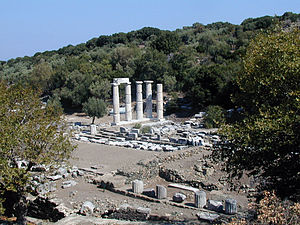Kabiri: Difference between revisions
No edit summary |
No edit summary |
||
| Line 1: | Line 1: | ||
[[File:Samothraki Hieron.jpg|thumb|300px|The Kabeirion on [[Samothrace]].]] | [[File:Samothraki Hieron.jpg|thumb|300px|The Kabeirion on [[w:Samothrace|Samothrace]].]] | ||
The '''Kabiri''' (also ''Kabeiri'', Cabeiri or Cabiri, from {{Greek|Κάβειροι}} ''Kábeiroi'' "the great ones", {{Latin|Cabiri}}) were unspecified [[chthonic gods]] of both sexes from [[w:Asia Minor|Asia Minor]], who were often associated with fertility, seafaring or blacksmithing. They were worshipped as "Great Gods" ({{Greek|Μεγάλοι Θεοί}} ''Megáloi Theoí''), especially on [[w:Samothrace|Samothrace]], but also on [[w:Imbros|Imbros]] and [[w:Lemnos|Lemnos]]. There were other cult sites in [[w:Macedonia|Macedonia]], [[w:Boeotia|Boeotia]], [[w:Pergamon|Pergamon]] and [[w:Miletus|Miletus]], among others. However, the cults were sometimes very different. | The '''Kabiri''' (also ''Kabeiri'', Cabeiri or Cabiri, from {{Greek|Κάβειροι}} ''Kábeiroi'' "the great ones", {{Latin|Cabiri}}) were unspecified [[chthonic gods]] of both sexes from [[w:Asia Minor|Asia Minor]], who were often associated with fertility, seafaring or blacksmithing. They were worshipped as "Great Gods" ({{Greek|Μεγάλοι Θεοί}} ''Megáloi Theoí''), especially on [[w:Samothrace|Samothrace]], but also on [[w:Imbros|Imbros]] and [[w:Lemnos|Lemnos]]. There were other cult sites in [[w:Macedonia|Macedonia]], [[w:Boeotia|Boeotia]], [[w:Pergamon|Pergamon]] and [[w:Miletus|Miletus]], among others. However, the cults were sometimes very different. | ||
Revision as of 10:01, 26 August 2021

The Kabiri (also Kabeiri, Cabeiri or Cabiri, from Greek: Κάβειροι Kábeiroi "the great ones", Latin: Cabiri) were unspecified chthonic gods of both sexes from Asia Minor, who were often associated with fertility, seafaring or blacksmithing. They were worshipped as "Great Gods" (Greek: Μεγάλοι Θεοί Megáloi Theoí), especially on Samothrace, but also on Imbros and Lemnos. There were other cult sites in Macedonia, Boeotia, Pergamon and Miletus, among others. However, the cults were sometimes very different.
The Kabirs were regarded as children of the Great Mother, the Kabeiro (also Cabeiro, Greek: Καβειρώ). According to Greek mythology, she was a daughter of the shape-shifting sea god Proteus and lived as a sea nymph on the island of Lemnos. After she was cast out of Olympus, the Greek smith god Hephaestus had three sons with her. According to some ancient authors, three Kabeiri and three Kabeirian nymphs (Greek: τρεῖς Καβειρίδες νύμφαι treís Kabeirídes nýmphai) were worshipped on Lemnos.[1] Among others, Kabeiro was identified by the Greeks with the mother of the gods Rhea, but also with Demeter, Hecate and Aphrodite.
Literatur
- Karl Kerényi: Die Mythologie der Griechen, Band I, Deutscher Taschenbuch Verlag, München (1966)
- Rudolf Steiner: Wahrspruchworte, GA 40 (2005), ISBN 3-7274-0401-9 English: rsarchive.org German: pdf pdf(2) html mobi epub archive.org
- Rudolf Steiner: Der Goetheanismus - ein Umwandlungsimpuls und Auferstehungsgedanke, GA 188 (1982), Achter Vortrag, Dornach, 25. Januar 1919 English: rsarchive.org German: pdf pdf(2) html mobi epub archive.org
- Rudolf Steiner: Geistige Zusammenhänge in der Gestaltung des menschlichen Organismus, GA 218 (1992), Stuttgart, 4. Dezember 1922 English: rsarchive.org German: pdf pdf(2) html mobi epub archive.org
- Rudolf Steiner: Mysteriengestaltungen, GA 232 (1998), ISBN 3-7274-2321-8 English: rsarchive.org German: pdf pdf(2) html mobi epub archive.org
- Rudolf Steiner: Die Weltgeschichte in anthroposophischer Beleuchtung und als Grundlage der Erkenntnis des Menschengeistes, GA 233 (1991), ISBN 3-7274-2331-5 English: rsarchive.org German: pdf pdf(2) html mobi epub archive.org
- Rudolf Steiner: Geisteswissenschaftliche Erläuterungen zu Goethes «Faust», Band II: Das Faust-Problem, GA 273 (1981), ISBN 3-7274-2730-2 English: rsarchive.org German: pdf pdf(2) html mobi epub archive.org
- Rudolf Steiner: Eurythmie – Die Offenbarung der sprechenden Seele, GA 277 (1999), ISBN 3-7274-2770-1 English: rsarchive.org German: pdf pdf(2) html mobi epub archive.org
- Rudolf Steiner: Vorträge und Kurse über christlich-religiöses Wirken, V. Apokalypse und Priesterwirken, GA 346 (2001), ISBN 3-7274-3460-0 English: rsarchive.org German: pdf pdf(2) html mobi epub archive.org
 |
References to the work of Rudolf Steiner follow Rudolf Steiner's Collected Works (CW or GA), Rudolf Steiner Verlag, Dornach/Switzerland, unless otherwise stated.
Email: verlag@steinerverlag.com URL: www.steinerverlag.com. Index to the Complete Works of Rudolf Steiner - Aelzina Books A complete list by Volume Number and a full list of known English translations you may also find at Rudolf Steiner's Collected Works Rudolf Steiner Archive - The largest online collection of Rudolf Steiner's books, lectures and articles in English. Rudolf Steiner Audio - Recorded and Read by Dale Brunsvold steinerbooks.org - Anthroposophic Press Inc. (USA) Rudolf Steiner Handbook - Christian Karl's proven standard work for orientation in Rudolf Steiner's Collected Works for free download as PDF. |
References
- ↑ Strabo, Geography, translated by Horace Leonard Jones; Cambridge, Massachusetts: Harvard University Press; London: William Heinemann, Ltd. (1924). LacusCurtis, Online version at the Perseus Digital Library, Books 6–14
